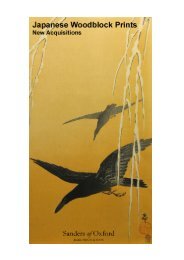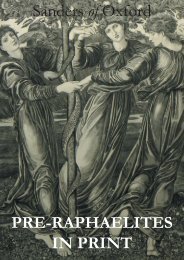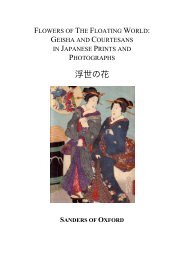Surimono catalogue FINAL WEB.pdf - Sanders of Oxford
Surimono catalogue FINAL WEB.pdf - Sanders of Oxford
Surimono catalogue FINAL WEB.pdf - Sanders of Oxford
Create successful ePaper yourself
Turn your PDF publications into a flip-book with our unique Google optimized e-Paper software.
<strong>Surimono</strong> is the name given to a type <strong>of</strong> privately published Japanese<br />
woodblock print that became especially popular in the first third <strong>of</strong> the<br />
nineteenth century. Literally meaning “printed object”, surimono can refer<br />
to text, pictures, or frequently, a combination <strong>of</strong> the two. The word was<br />
first recorded as early as 1094 but it wasn’t until the1760s that the term<br />
began to be applied to a new form <strong>of</strong> woodblock print: that which was<br />
privately commissioned and published in limited editions. Experiemental<br />
and elaborately printed, surimono were designed by the leading ukiyoe<br />
artists <strong>of</strong> the day and amateurs alike, <strong>of</strong>ten to commemorate special<br />
occasions such as the New Year, and distributed amongst friends and<br />
associates.<br />
The surimono tradition <strong>of</strong> privately distributed woodblock prints can be<br />
split into two distinctions: publications to announce or commemorate<br />
events such as musical performances or national holidays, and<br />
publications which combined image and verse, <strong>of</strong>ten commissioned<br />
by poetry societies. The images were used to illustrate the seventeen<br />
syllable haiku or the thirty-one syllable kyōka, enriching the verse with<br />
visual context and vice versa. Although trimmed <strong>of</strong>f in some cases, text<br />
also features in announcement surimono, and is one <strong>of</strong> the elements that<br />
sets this tradition apart from commercially published woodblock prints.<br />
The advent <strong>of</strong> surimono in the 18 th century coincided with major<br />
advances in colour printing in Japan and surimomo artists were able to<br />
take full advantage, experimenting with new pigments and techniques.<br />
Artists designing surimono did not operate under the same constraints<br />
as designers <strong>of</strong> commercial prints, and having only the wishes <strong>of</strong><br />
the commissioner to restrict them, these works were <strong>of</strong>ten produced<br />
as deluxe prints with an abundant use <strong>of</strong> gold and silver pigments,<br />
delicate and complicated colour palettes, elaborate embossing and<br />
complicated designs. Printed on hōsho, a thick, <strong>of</strong>ten unsized, paper, the<br />
smaller shikishiban format used for surimomo was particularly suited to<br />
embossing and absorbing pigments. This enabled artists to apply more<br />
complicated techniques than in larger prints where colour had to cover a<br />
larger area or the paper was harder.<br />
Unrestricted by commercial demands, privately published surimono<br />
allowed the artist to explore a wider range <strong>of</strong> subject matter. <strong>Surimono</strong><br />
designers <strong>of</strong>ten pioneered subject matter that found its way into<br />
commercial prints later. For example, such works <strong>of</strong>ten depicted women<br />
engaging in domestic activities associated with the New Year. The “still<br />
life” flourished in surimono design while being neglected in standard












